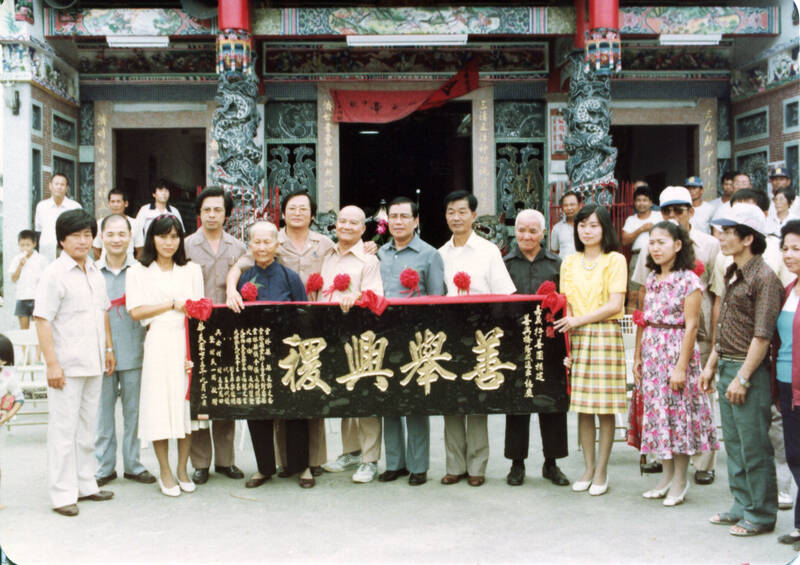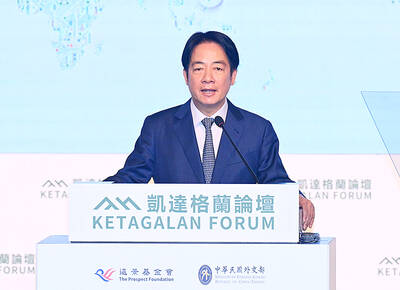March 3 to March 9
Surrounded by three rivers, Fengshan Village (豐山村) was cut off from the outside world after Typhoon Herb washed away its only concrete bridge in August 1996. Villagers for the next few months relied on helicopters for food and medical emergencies, but the situation was dire because they had no way to make a living.
With the government dragging its feet, village chief Huang Hsin-fa (黃新發) turned to the charity group that built the destroyed Shantian Bridge (善天橋) in the first place — the Chiayi Charitable Organization (嘉邑行善團).

Photo courtesy of Fengshan Village
Before 1986, the village only had a wood plank bridge that was unusable during bad weather. It was raining hard on Huang’s wedding day that year, and the procession was delayed for two hours because they couldn’t cross the Shigupan River (石鼓盤溪) — in the end they had to hire a truck to transport the cars over, he says in a Taiwan Panorama (台灣光華) article.
One of the guests happened to be a member of the Chiayi Charitable Organization, and he reported this incident to founder Ho Ming-teh (何明德). A few months later, the Shantian Bridge was completed.
Ho was invited back to the village in October 1996, and his band of about 200 merry volunteers began work just two weeks later. On March 9, 1997, the new Xingtian Bridge (行天橋) was inaugurated. Due to the typhoon eroding the river banks, this 120m structure was 80m longer than its predecessor. It also featured the latest anti-flood technology. It cost NT$13 million, coming from donors who were only allowed to give a maximum of NT$100 every three months.

Photo courtesy of Yunlin County Culture and Tourism Department
Xingtian Bridge was the 222nd bridge that the group had built since 1971, when they first began helping connect isolated or needy communities. Today they have built more than 600.
(Note: The recently embattled Ho Ming-teh Charitable Organization (何明德行善團) is a different organization founded by Ho’s daughter and her husband after his death in 1998. The scandal-hit ROC Chiayi Charitable Organization (中華民國嘉邑行善團) is also a separate group.)

Photo: Ting Wei-chieh, Taipei Times
FILLING POTHOLES
Lai Shu-ming (賴樹明) writes in the 2003 book Fools Build Great Bridges (憨人造大橋) that during the 1960s, a group of volunteers began repairing Chiayi’s dirt roads, donating rice and purchasing coffins for needy families. The roads were often in poor condition after it rained, resulting in many accidents.
The center of this movement was Lin Ping-shan (林炳山), an administrator in Chiayi’s City God Temple (城隍廟), who often encouraged those who gathered at the temple to do more good deeds. Starting from a diverse group of seven people — including a city councilman, dentist, shoe store owner, street vendor and laborer — they began attracting more locals to their cause, each contributing their expertise and resources.

Photo: Fangyuan Township Office
To remain anonymous, they often did their road work at night. Local reporter Chen Shih-ying (陳世英) often noticed damaged roads being fixed up by morning, and was determined to uncover the mystery. After standing watch for several nights, he finally spotted the volunteers and wrote an article about it. They were dubbed the “Chiayi Volunteer Organization” by the media, and they later adopted the name themselves.
While the organization’s official records show that the first bridge was built in 1971, Lai writes that in 1967, a junior high school student was swept away while trying to cross a bamboo bridge in the city. Locals knew that the group had experience mending drawbridges, so they asked if they could help build a better one. About 20 people participated in this effort. Residents were wary at first about crossing this “amateur” structure, but experts and officials came and reassured them that it was secure.
The group replaced it with a concrete structure in 1990, naming it Xuanming Bridge (玄明橋), only then was it listed as their 65th bridge.
CONNECTING COMMUNITIES
Ho Ming-teh joined this group in 1968, reportedly after a friend was badly injured when his motorcycle hit a pothole. Although Ho trained as a civil engineer, he had left the field early on and ran a consignment grocery shop. But, according to his profile on the Ramon Magsaysay Award Foundation, he was able to “assess the need for a bridge, draw up a plan, purchase the materials and coordinate with local officials” and professionals.
Chiayi’s countryside had many bridges that were falling apart, many villages had no bridges at all and residents had to ford the rivers or take the long way around mountains to reach other towns. Ho’s arrival allowed the group to start building solid, concrete structures for needy communities.
In 1971, the group built their first such bridge in Jhongpu Township (中埔), which is considered their first official effort. Lai writes that villagers approached the group hoping for a better way to transport remains to the local graveyard; at that time they had to carry the coffins over a one-meter wide wooden bridge or take the long way around the mountain. Other reports, however, state that they decided to build it after they heard that two young brothers drowned while attempting to cross a river.
Each member pitched in NT$5, with Ho designing the bridge. One volunteer drove the materials to the foot of the mountain, which was manually carried up to the site. They had no machinery, but they were able to complete this 8.9m-long structure in a month.
This bridge is long gone; since there were no photos or records kept then, members spent years looking for its remains. They finally uncovered the pier in 2018.
The group soon made bridge building its main focus. In 1977, after their 44th bridge, Lin left to focus on other charitable activities while Ho assumed leadership. One of his trusted assistants was Kuo Shu-fen (郭淑芬), who joined the group with her mother in 1968 after graduating from a school for fashion design. She took part in all the construction tasks and gained a thorough understanding of bridge building, and eventually began helping Ho draw the blueprints as his eyesight worsened. By the 1980s, Kuo was also able to design bridges, Lai writes.
GROWING NUMBERS
At first, the group had just 300 regular donors and about 30 volunteer builders. Lai writes that during the 1970s and 1980s, a dozen regulars were over 70 years old, while the youngest was in first grade. Their ranks grew exponentially due to the media attention that came with the completion of each bridge, and they expanded their reach to Yunlin and Tainan. However, Ho limited monetary contributions to NT$100 per person every three months.
Their profile skyrocketed after Ho recieved the Ramon Magsaysay Award for “improving rural Taiwan with good deeds and sturdy bridges” in 1995, swelling to 220,000 donors and about 200 builders by 1997.
In 1998, they embarked on their most ambitious project to date — Xingyuan Bridge (行圓橋), which would cross the Bajhang Creek (八掌溪) at Chukou Village (觸口村). At the time, villagers mostly relied on a suspension bridge, but due to weight limitations they had to find other ways to transport their produce during harvest season, often crossing the river by foot. It was a challenge due to the wide riverbed, erosion and height of the bridge, and someone suggested that they leave it to the government, but Ho and his volunteers believed that they could handle the job.
With hundreds of volunteers and experts toiling by the river every weekend, they completed the 160m-long, 21m-tall, 12m-wide structure in June 1998. This was Ho’s final bridge, as he died four months before its completion.
During Ho’s life, the group was an informal organization, but before he died he expressed his wishes to have it officially registered. However, due to differences between his family and the charity’s volunteers, the group split into three. Two of them have been mired in scandals in recent years, causing much confusion due to their similar names; the Chiayi Charitable Organization has had to repeatedly proclaim that they have nothing to do with the other two.
Taiwan in Time, a column about Taiwan’s history that is published every Sunday, spotlights important or interesting events around the nation that either have anniversaries this week or are tied to current events.

Last week, on the heels of the recall election that turned out so badly for Taiwan, came the news that US President Donald Trump had blocked the transit of President William Lai (賴清德) through the US on his way to Latin America. A few days later the international media reported that in June a scheduled visit by Minister of National Defense Wellington Koo (顧立雄) for high level meetings was canceled by the US after China’s President Xi Jinping (習近平) asked Trump to curb US engagement with Taiwan during a June phone call. The cancellation of Lai’s transit was a gaudy

From Godzilla’s fiery atomic breath to post-apocalyptic anime and harrowing depictions of radiation sickness, the influence of the nuclear bombings of Hiroshima and Nagasaki runs deep in Japanese popular culture. In the 80 years since the World War II attacks, stories of destruction and mutation have been fused with fears around natural disasters and, more recently, the Fukushima crisis. Classic manga and anime series Astro Boy is called “Mighty Atom” in Japanese, while city-leveling explosions loom large in other titles such as Akira, Neon Genesis Evangelion and Attack on Titan. “Living through tremendous pain” and overcoming trauma is a recurrent theme in Japan’s

As last month dawned, the Democratic Progressive Party (DPP) was in a good position. The recall campaigns had strong momentum, polling showed many Chinese Nationalist Party (KMT) lawmakers at risk of recall and even the KMT was bracing for losing seats while facing a tsunami of voter fraud investigations. Polling pointed to some of the recalls being a lock for victory. Though in most districts the majority was against recalling their lawmaker, among voters “definitely” planning to vote, there were double-digit margins in favor of recall in at least five districts, with three districts near or above 20 percent in

The great number of islands that make up the Penghu archipelago make it a fascinating place to come back and explore again and again. On your next trip to Penghu, why not get off the beaten path and explore a lesser-traveled outlying island? Jibei Island (吉貝嶼) in Baisha Township (白沙鄉) is a popular destination for its long white sand beach and water activities. However, three other permanently inhabited islands in the township put a unique spin on the traditional Penghu charm, making them great destinations for the curious tourist: Yuanbeiyu (員貝嶼), Niaoyu (鳥嶼) and Dacangyu (大倉嶼). YUANBEIYU Citou Wharf (岐頭碼頭) connects the mainland